





































































































































008 From Mortonsarchive
This month we find theenormous GermanHerbertSchek,who putBMW onto theroute that would lead to the pivotal R80 G/S –deep in mud!
010 Your Guide To:Suzuki Stinger
This unique bi ke is purelyfun on two wheels and doesn’t hangaround. Have youeverseen anything li ke it?
020 Next month
We takea thorough look into the Norton Commando. Looking back, it’s incredi ble it even made it to thedealers
022 Subscribe!
Save your pennies with ourofers and save your legs by having it delivered. Alittlebit of joyonce amonth
024 News
All theessentialgoings-on in our world of old bi kes
026 Your Guide To:Ducati 900SS
Belt driveease, the looksofthe WSBwinning 851, blood-red paintwork and, er,nosteeringlock. But the SS fami ly helped Ducatitowhereitisnow
034 Your Mini Guide To: Ducati Monster
Aparts bin special to introduce a town bi ke,the Monster has become an institution, copied by many
038 Old Bike Mechanics Directory
They’reheretohelp us, theyknow what needs doing, so supportthem!
039 What’son
Shows and events areout there, so getsome inspiration
040 BMW heroes at the TT
Helmut Dahne took 1939 Senior winner GeorgMeier’s fami ly to the Isle of Mantosee where his famous victory occurred
046 Vincent Super Hooligan Racer
Howabout a1600cc Vincent V-twin that wonDaytona?It’s awesome!
054 Letters
Letusknowwhat youthink, showus your bi kes, and youcould win aprize
056 Frank Recalls: Honda CB750 F2
Mostknowofthe Honda CB750, but what wasitlikethrough the eyesofaBritish twin fan?
064 Kitting out for aBritish bike
What tools do youneed?What bookswillcome in handy? We help youset up foraBritish bi ke
066 British Bike Guide part three
In the last instalment of our series, we look at Triumph to Vincent… some real beauties in there
076 Reader adverts
There’s abig rangethis month, have look to see if anything tempts you
088 Tickover
Oli’s monthlymusings includeawinter get-together and acouple of shows
090 In TheWorkshop:Cerakote coating
This newultra-thin coating could be the answertomanypeople’sbikes
094 In RebTheWorkshop:uildyourcarburettor
They’refiddly, theyneed care, but theyare not complicated
Banish that stutter
098 Frank’sFamous Last Words
Should Frankbuy amodern classic to replace his old classics?Discuss






















Greetings all,
Hope we fndyou warm,content and well-fed. Because here in the UK it hasn’t been that great outside so I’m guessing manyhaven’tevenlookedatany steeds, and as Ifound out to my cost, youare the sensibleones.
The weather waslooking alright, if slightlychilly,last week, when Iwas due at afeatureinLeicestershire, about140 miles away.I’m lucky enoughtohavebuilt up top-class kit over theyears (Rukka, Daytona boots, Arai, as people have asked –all very expensive,but all do what they saytheywillifyou look afterthem –boots aremorethan 10 years old) and the BMW has averyrespectablefairing with built-in footwarmers, so Iset off, lookingforward to my ride.After all, I’m always harping on about riding in all weathers…
The weather wasn’tthat bad,there wasn’ttoo much rain, andit wasn’tthat cold. But put it all together and youhave acake mix of riding hell.The salt the gritters hadlaid madethe roundabouts slimyand unpredictable, the rain loosened


up the salt, the lorries helped it off the road surface and literallythrew it at me and the BM…intoevery nook and cranny. It gave my bike the appearance of an antiquedug up from the Krakowsalt mines. My visor mayaswell have been cleaned with sandpaper,and Ilooked like aghost on arrival.
The wayhome waswetter,but less salt (as it wasall on the bike) –but dark. Istill couldn’t see.Still, my feet were nice and warm! Until Igot home,when Ihad to rinse the poor bikedown. And then again in the morning when Icould actually see Ithen had to drythe bike off, pop it onto the ramp (because I’m old and Ican) and further clean it, beforeapplying anticorrosion snakeoil. If Iprattle on again about riding in all weathers, tell me I’m an idiot and ignoreme. Yet, apartfromthe cleaning, drying the boots out, cleaning the clothing and stripping my helmet, I enjoyedit.
We did have agood ride the weekend before, blessed with clear,sunnyskies, but wrapped in fvedegrees! Still, up to Blakeneyonthe coast, coffee and cake, and backagain wasenough to blow the cobwebs out.
The local Anglian Car Auction had a classic sale recently. My friends Mattand Alan went, and Matt bought aT140 that looks pleasinglyoriginal. He said prices for bikes looked stronger than last year andfar better than cars. But restored bike values seemed average, while projects


were farhigher than he’dhavethought. It seems people want to payless for what theywant, so theyare buyingprojects. I’m intending to sell afew bikes this year,so will report back– we need anew roof!
Everyone seems to be tinkering if I pop over.Johnand Tomweretrying to getMollythe M31 fring, while Jonhas been fnding all sortsofbodges anddodgy shims in the wheel of his Tiger100.And Matt has been hereftting new‘bars to his Enfeld to work around an injury. Nothing beats ingenuity to getaround an injury!
That’sitfor now. Get the heater on in the shed, treat yourself to something shiny, andenjoy the mag.
All our best,
He
En du ro Ch am pi on sh ip
In 1966 SchekusedBMWsfor his campaigns. At theISDTheldinSweden, East Germany, he wonoverall team honours,atWes tGermany collec ted theSilverVase, andwon hisclass on his factor y- builtmachine.But it wasnot to be,asBMW decidednot to compete in trials thefollowing year.Schek went back to Maico.
Theyear1969saw BMWdecidet hat enduro couldbegoodadver tising again when it introduced theBMW /5 family, so theser vicesoft he giantSchek were requiredoncemore.HerodeanR75/5 at Garmisch,B avaria,Germany,but the bike wastoo heav yand uncompet it ive forany of thet hree entered. Schekprotested to theBerlin factor y, campaigningfor alighter machine, butwhenitsaidno, he took it on himself. He gott he weight down immensely– from thes tandardbike’s 210k gtoanincredible135kg –and then furt herevolutionswereas lowas128kg.In1973, BMWgained really valuable promot ionfrom it s ISDT bikeswhent he race washeld in Massachusett sand Herber twon agoldmedal .And thebikes by now looked readyfor anyt hing.Schek went into product ionafter beingasked to producebikes forother riders andbuilt 17 in total.
Overall, he competed in 25 ISDTs, winningfour. He competed in 15 Paris Dakar rallies, as well as taking what he’s learnedand builds BMWs fort he ParisDakar rally. Aged in his80s,hewas st illcompeting in ‘vintage enduro.’
TheBMW R80G/S changed motorcycling foreverwhenintroducedin 1980.But Herber tSchek played apivotal part in thecreationofthatG/S























































llingout of the and your meagre ning ahole in your termined to go looking morning, acopyof Mechanics stuffedinto ant ascooter,and lippingout of fashion, ancial resourcesmight Small British bikes ter.Nomatter how ent says youshould ’the Francis-Barnett out of production for that wasn’t going to cut bus stop.Your local bike an array of small tthose aremostly out our pocket. Honda uwith aCBorSS125 ell, weird, with lots wasakiisn’t here win is quite groovy ra 125, while being with chromed tank launched asimilar bike ,the T125, which Super Six 250 twin wash and wasnot smostly sold in Japan,
t’s 1969 You re stro g out the factory on a Friday night and your apprentice wages are burning a hole back pocket. You are determined to for wheels on Saturday a copy of Motorcycle and Three-Wheeler your overalls. If you don’t want a scooter, and they were quickly slipping out of fashion, your limited fnancial resources might just run to a 125. are dead in the water No matter much the Government says you should be ‘Backing Britain,’ the Plover had been out of production for two years and wasn’t to it down at the bus stop Your local shop might have an of small Italian bikes, but those are mostly out of the range of your tries to tempt you with a CB or SS125 twin, but they are a bit, well, of bits to worry about. Kawasaki isn’t yet. Yamaha’s AS125 twin groovy and impressively fast for a classically good-looking with chromed panels. Suzuki had a similar bike to the Yamaha in 1966, the looked like a the T20 Super Six 250 that had shrunk in the was not unattractive. This was mostly in



but aselect fewalso escaped into the international market. The engine for this frst T125 came from an earlier 125cc two-stroke twin, the AS125, sold from 1963. And then, suddenly, therewas anew madas-hecktwin, with eye-popping styling: the Suzuki T125 Stinger It looked like atinyrocketship and came with lines likenobodyhad ever seen before. Or

“What T125 Sti er did owe much i ts origins to motor cle Suzuki was going to a massive but sn’t qui te they would liked. wa fun li ttle


5Stinger didowe much of itsorigins to is a Suzuki thought wasgoing to be amassive seller, as successful as theywould have li ked. This semi off-roader called the TC120 Trai lCat.”



since,some maysay.Although it lacked abit of top-end powercompared to the Yamaha, the 15bhp engine wasmoretractableatlower speeds, andthe kudosofbeing made by achampionship-winning manufacturerhelped sales too.
The T125 Stinger owes nothing to the earlierT125. However, thelines of the petrol tank were borrowed from thoseused on apairofpressed-steel-framed 90 and125cc single-cylinder models whichhad become availablein1967.
What the T125 Stingerdid owemuchof its origins to is amotorcycle Suzuki thought wasgoing to be a massive seller,but wasn’tquite as successful as they would have liked. This wasa fun little semi off-roader calledthe TC120Trail Cat.Thiswas oneof Suzuki’s high-techtinybikes of theday,a motorcycle with a single-cylinder engine mated to dual-ratio gearbox to improveoff-road performance.This used akind-of trellis frame,but with atubed cradle protecting the engine.The TC120 wasa lot of fun, and that dual-ratio gearboxwas used on severalofSuzuki’sTCmodel offroaders into themid-1970s.
When Suzuki’sengineersgot to work to create their new125cc sports bike,theytook theTC120 frame and called it the Tri-Form.Theyclaimed it wasraceproven, whichitcouldsort-of layclaim toasSuzuki’s smaller race bikes did hang theirmotors off the top of the frame.Theyremovedthe off-roader’sprotective






cradle and came up with an all-new, twin-cylinder, two-stroke motor to hang offthe frame rails.
The newengine boreapassingresemblance to atwo-cylinder version of the new A50 motor which used ausing disc valvewith acarbonthe endofthe crank. Themotor for the Stinger had twin two-stroke barrels mounted on acommon crankcase.Inoperation, it wasa conventionalpiston-ported twin with two downdraught carburettors and CCIauto lube.The crankcases were horizontally split, and the cylinders were angled upwards onlya fewdegrees from being parallelwiththe road. The fns were longitudinal and adorned strikinglyattractive cylinderheads with the barrel fnning extended ontothe crankcases. This was the sort of thing Japanese manufacturers used to come up with at the drop of ahat,rather than leaving their designs miredindevelopmenthell for half adecade beforethe machines appear,ashappens today
With styling that seemed to come from Saturn, and an engine using principles thatwereoutside Suzuki’s usual modus operandi, it all came over as radical –even for the late 1960s. The bodywork and styling were something else,man
With aframe thelike of whichhad never been seen before, Suzuki put in oneof those bonkers exhaust systems that theJapaneseusedto be so good at. A pair of pipes bent into adelicious seriesofcurves swooping down either side,curving tightlyoverthe top of thecrankcasesand then straight backwards, looking morelike rocket engines than exhausts. Of course,being the late 1960s, theyhad to be as light as technologicallypossible to reduce overall weight and make the bike faster.Todothis, theyweremade of materials with the structuralrigidity of tinfoil and next-to-uselessrust preventing quality for an extrashortshelf life.But that would be an issue for the second owner,ofwhichnoone cared
It waslike the designers got together in a conference…












“Let us create apowerful smallengine, usingall our engineering expertise, make it watch-like in its construction, and hang it offa ground-breaking frame of our owndevising.”
“Yes, master,but what of the exhaust system, how shall we make those?”
“Oh, use some those bits of scrap metal out the backofthe factoryweused onnoodle delivery tricycles that in turn used steel that wasleftoverfrom the war, beat itout as thinlyaspossible,and give it an impossiblebend then coat it with alayer of chrome less than amicron thick.”
As though to bamboozle and frustrate later restorers, these exhausts were chrome on the frst


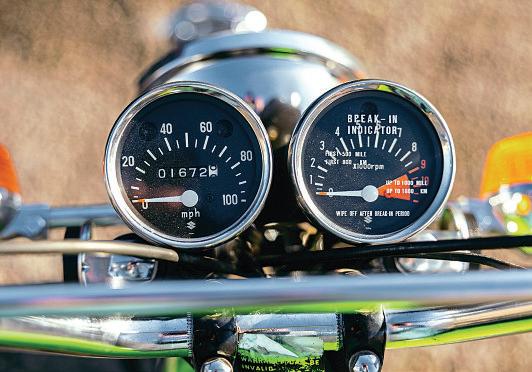

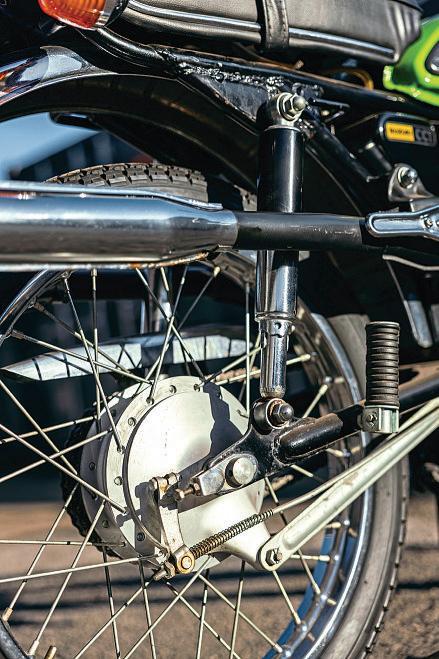
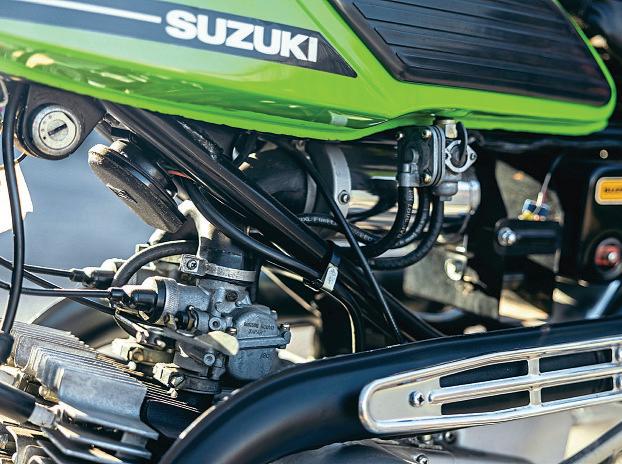
models with blackend cans, had fullychromed pipes on the year twomodels, and blackwith chromedend cans on the last year’smodels. The blackpaint also had its work cut out preventing rust. Somemodels in Australasia, South America and the Caribbean came with low-slung exhausts with conventional silencers, too.All the profles looked great, though.
Stylistically, it wasone of the frst Suzuki offerings to ditchthe headlight nacelle and instead had had twoclocks in abinocular housing witha very slim, tucked-awayheadlight. It came with threedifferent tanksduring the productionrun,too
Notevery market wanted alow-barred pseudo race bike, so Suzuki put wide,uprighttrials ‘bars on US models, and this created what wasthen known as aCanyonRacer. Theyweremade to be used on the twisting roads of California’shills aboveSan Francisco and Los Angeles but giventhere waswhere most of the US bikepress wasbased andwheretheir brain-fried writers would test them, this design made sense. Cycle World writerswereamazed by the Stinger, praising the ‘Italian’ styling, the fnish,the chrome, and the brakes, and ravedaboutthe performance.
“The newSuzuki T-125 owner will be convinced he has put in an order forafabled racing iron.Ifhe stops to consider for amoment, he will discover he also has ordered smooth, vibrationless, quiet, everydaytransportation, adelightful machinewhich is suffcientlyfexible and docile for wife or galfriend to ride,and abike that is sporting enough to please the teen-agedmotor sophisticate.That’saverylarge order for averysmall motorcycle.The Suzuki T-125 Stinger flls that orderinevery respect.” – Cycle World, February1969.
In the real world, buyers found that theStinger followedJapanese design principles of theday in the handling department. Thatis, the forks andshrouded shockswerecheap and bouncy, the dampers not knowing if theywerecoming or going, andthe brakes were basicand just about effective on wetEuropean roads. But as the bikeweighed onlyatinyamount, this wasnot amajor issue
In Japanese and European markets, thebikes came with slightlyraised or even fat ‘bars to give the Stinger an aggressive café racer stance
The little twin also came with a90ccengine While it wascommonlycalled the Stinger, it was also called the Wolf in the FarEast andAustralasia. Suzuki saidthis model, with aslightlydifferent tank, wasdesigned to “evoke the image of awolf dashing toward its prey.” It wasalso named theFlyingLeopard in some European countries.
Whywould anybody want atinylittle Suzuki stroker youcan’t getbitsfor? With skinnytyres and questionable suspension?Because it wi ll be as mad as asack full of badgers, cute asyour first girl/boyfriend, andwillturnheadseverywhereyou go.You’ll findyour misspent youth flooding back into your memory.Admittedly, youcould buy a big, chunky classic for£4500, but where’s the fun in that? Riding small bi kesfastisway better than riding big bi kesslowly. Every bi ke less than 200cc I’veridden has left me with ahugegrin on my face. And everybody lovesthem.Turn up to ameet on one, park it next to aGold Star,and see the reaction. Tinybikes equals hugefun.Admittedly, my bui ld makes me look completelyabsurd on one, butif youare 5ft 6in tall andnine stone, the world is your mollusc.
This is purely my way of thinking, butbikes arefor riding, forfeeling thejourney, and even tinkering with, not beingseen on. Icareasmuch about what others think as Idoabout East Enders Street. But then Isaw this bi ke:the immaculate, eyepoppinglybrightSuzuki Stinger.Bizarrely, the first thingIdid waspickitup–which Icould –asitlooks so minimal,sosmall. Then thereisthe detai l, which is as good as anyBritish 650twin or Italianmulticylinder.The style is unique, brave, and if anything can excite ayoung’un, it’saStinger.OrRazzle
Even sitting on it felt greatand raised asmi le. Ididn’t ride this one, yousee, but afriend’s, and Ifelt my helmet would stretch, Iwas smi ling so much. All the revs, all the time,crouching down, finding narrow streetswith tall bui ldings justsoI could hear it reverb… it did something to me. Oli’s right –the best fun riding can be hadonasmallbike and, at last, I’m starting to understand the crazefor Japanese 50s, 125s and 200s. I’vebeen missing out.
The engine was, Suzuki claimed, designed for high-power, high-speed performance, andgenerated maximum horsepower of 15.1bhp at 9000rpm anda top speed of 80mph, even more. On the showroom foor,the Stinger wasdesigned primarilytotake on Yamaha’sfeisty 125cc AS1 twin.While it wasslightly outperformed in the top speed stakesbythe Yamaha AS1 and by afew pared-down-to-the-boneItalian bikes with race tuning, it outperformed Honda offerings and wasnotablyrapid with superior powerdelivery.Today, it will wipe the foor with anymodern learner-legal125, weighing afraction of currentmodels.
The Stinger wasn’tquite as quickasthe Yamaha, but Suzuki had nailed two-stroke powerdelivery


“The enginewas, Suzuki claimed, designed forhigh-power,high-speed performance, andgenerated maximum horsepowerof 15.1bhp at 9000rpm and atop speed of 80mph, even more. On the showroom floor, the Stinger wasdesigned primari ly to take on Yamaha’s feisty 125cc AS1twin…”
rather than out-and-outpower better than its tuning-fork badged rival. As with the 250cc twins it made,Suzuki’spower wasrather moreuseable than Yamaha’s, and indeed what wasproducedwas sometimes morelike afour-stroke thana two-stroke, atrickitpulled off again with the GT triples. The Stinger wasasmooth accelerating machine, thefuel heading into the downdraft carbs effectively.
MANUFACTURED: 1968-1971 ENGINE: Air-cooled,two-stroketwin BORE /STROKE: 43x43mm CAPACITY: 124cc POWER: 15.1bhp @8500rpm LUBRICATION: Two-strokeoil injection IGNITION: Points CARBURETTOR: Twin Mikuni TRANSMISSION: Chain GEARBOX: Five-speed foot change FRAME: Tubularconstruction FRONTSUSPENSION: Telescopicforks, hydraulic damping REAR SUSPENSION: Twin oil-damped shocks BRAKE: 5.5in sls drum TYRES: 2.50 x 18 front; 2.75 x18rear WHEELBASE: 1098mm DRY WEIGHT: 96kg TOPSPEED: 80mph
From acasual glance,the Stinger waslike nothing on earth –and in agood way. Everything about it wasdifferent, and while the frst-year models were fnished in arather restrained blue or redwitha splash of chrome,the second-year –and third-year –models made up for the lackofshinybits by being fnished in startlinglyday-glo green or gold

And then,almost as soonasitgot started, it was gone.In1971, with just three years in showrooms, the Stinger vanished. Suzuki wasleft with some very prosaic 125s to sell,including the enormouslydated home-marketedK125, with atwin-port, singlecylinder engine that remarkablystayedinproduction until 1990, and the commuter special B120P,successor to the Bloop.Therewas awholegamut of TSand TCoff-roaders and an earlyversion of the balloontyred VanVan. Giventhat thisperiod also sawSuzuki produce blisteringlyfast road racers andeventhe disastrousRE5 rotary, onemustwonder whatelsewas in thesaki other than rice
In 1975, the Sting e r’ss ucces s or arrive di nt he shap eo ft he GT125. It h ad n o t hing in com m on with the earlier bik e, apart fro mt he con ro ds an d pi st on s, an dw hile it looked m oreres pec tabl e, it wa smuchrawer,w ith ad ecided ly hoolig an element to it sp erf or ma nce
Today, thelittle Suzuki Stinger is still a showstopper.Enthusiasts spend years andsmall fortunes returning them to showroom condition. And therehangs the problemfor the would-be Stinger owner today: the major barrier,orchallenge, is the diffculty of fnding parts.Although it shares afew bits with other Suzuki modelsofthe period, much is simplyunique to the model.Take, for instance,the carburettors. The Italians, whenmounting carbs to an engine with afat layout,would either ft long, curved inlets or carbs withremotefoat chambers. Suzuki went in adifferentdirection and got Mikuni to make downdraft carbs with horizontal slides and cast-in
OWNERS’ CLUB
Suzuki Owners’ Club suzukiownersclub.co.uk
SPECIALISTS
AberMoto www.abermoto.co.uk/ Robinsons www.robinsonsfoundry co.uk Marcel Vlaandere www.classicsuzukiparts. nl
foat bowls. Good luck fnding parts for those. There wasatwin-pipe,single unit, vacuum-operated petrol tap too.
The seat wasunusual as the rear cutaway allowed it to hingebackwards, giving plenty of access to the underseat area; the rear mudguardisunique and unobtainable. Thereweredifferent front mudguards on the Wolf and the Stinger.Itcame withthree different tanks, too: the afore-mentioned different exhaust pipes, aselection of different electrical parts, and different seats.
And there’sthe rub.You could buy aStinger project,ifyou could fnd one,for perhaps £1, and then spend years collectingparts, payingpainters and chromers and engineers hundreds, if not thousands, of pounds and spend your evenings diligentlybending over what mayone daybeyour pride and joy– whichis, of course, one of the pleasures of classicmotorcycling.Oryou could just pop down toNewark tomorrowand hand over £4500 (the price of amodern Japanese performance 125), stickaboot on the left-hand kick-start, andhead up the road in acloud of blue smoke and nostalgia. Whichisalso one of thepleasures of classic motorcycling. Youpay your money, and youmake your choice…
Enormous thanks to Motorcycle Investment Services of Newark for the loan of its T125 Stinger.Asthis issue goes to press, this truly immaculate example is still available,at£4500. Visit misukltd.com





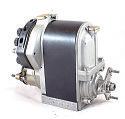





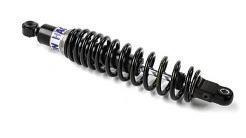




















EDITOR || Matt Hull
editor@classicbikeguide.com
PUBLISHER || Tim Hartley thartley@mortons.co.uk
ARTEDITOR || Kelvin Clements
PAGE DESIGNERS || Druck Media
PRODUCTION EDITOR || Lucy Wood
GROUP ADVERTISINGMANAGER || Sue Keily
ADVERTISING || Craig Amess 01507 529465 camess@mortons.co.uk
ARCHIVE ENQUIRIES || Jane Skayman 01507 529423 jskayman@mortons.co.uk
SALES AND DISTRIBUTION MANAGER || Carl Smith
HEAD OF MARKETING || Charlotte Park
PUBLISHING DIRECTOR || Dan Savage
COMMERCIAL DIRECTOR || Nigel Hole
EDITORIAL ADDRESS || Mortons Media Group, Media Centre, MortonWay, Horncastle, Lincs LN9 6JR
WEBSITE || www.classicbikeguide.com
GENERAL QUERIES AND BACK ISSUES || 01507 529529 24hr answerphone
Email: help@classicmagazines.co.uk Web: www.classicmagazines.co.uk
SUBSCRIPTION ||
Full subscription rates (but see pages 22 and 23 for ofer): (12 months 12 issues, inc post and packing)–UK £64.80. Export rates arealso available –see page 20 formoredetails. UK subscriptions are zero-rated forthe purposes of Value Added Tax.
DISTRIBUTION || Seymour DistributionLtd, 2East Poultry Avenue, LondonEC1A 9PT.
PRINTED BY || Acorn WebOfset Ltd, Normanton, West Yorkshire.
ADVERTDEADLINE || March6,2025 NEXT ISSUE || March26, 2025
©Mortons Media GroupLtd. All rights reserved. Nopart of this publication maybereproduced or transmitted in anyformorbyany means, electronic or mechanical, including photocopying, recording, or anyinformation storageretrieval system withoutprior permission in writingfromthe publisher




